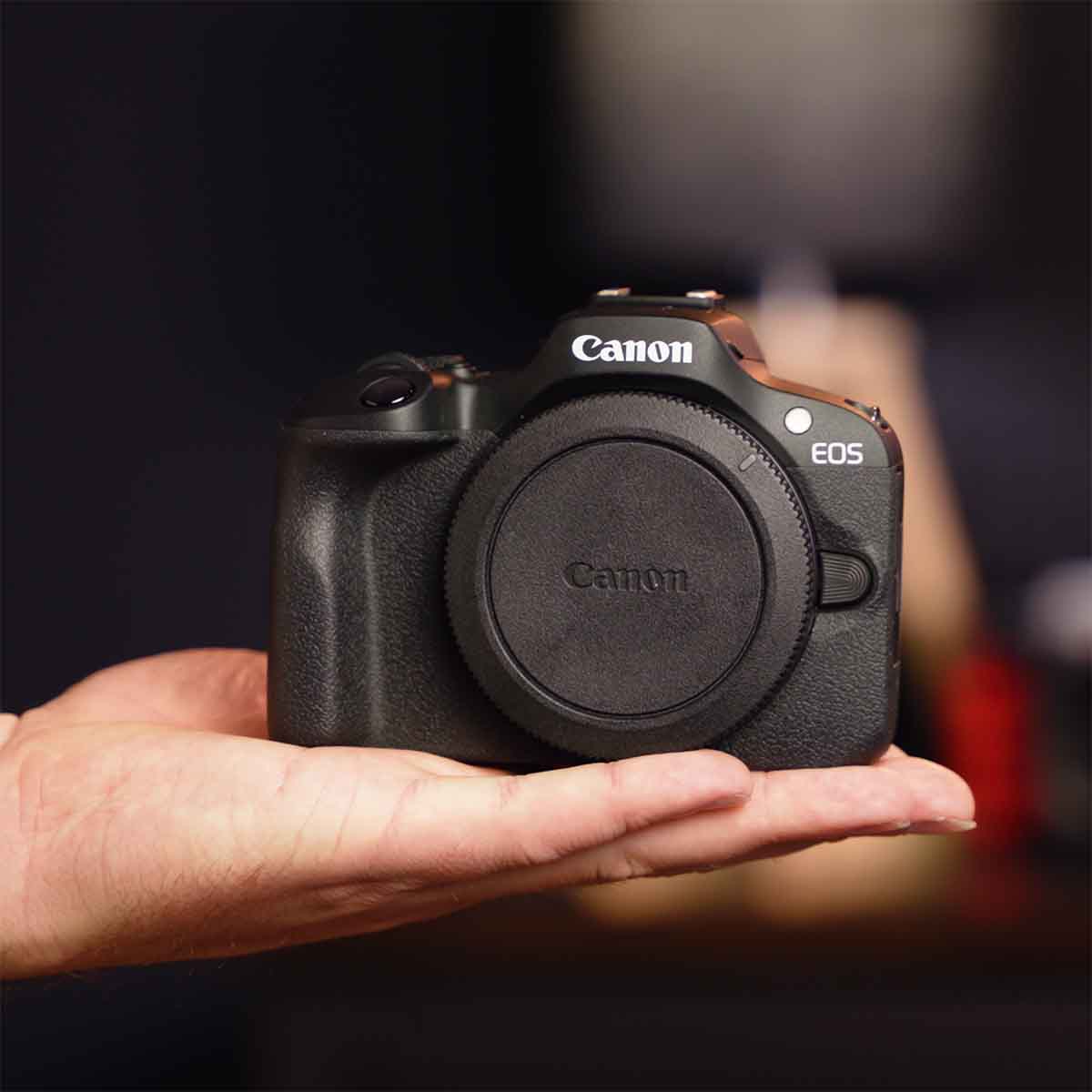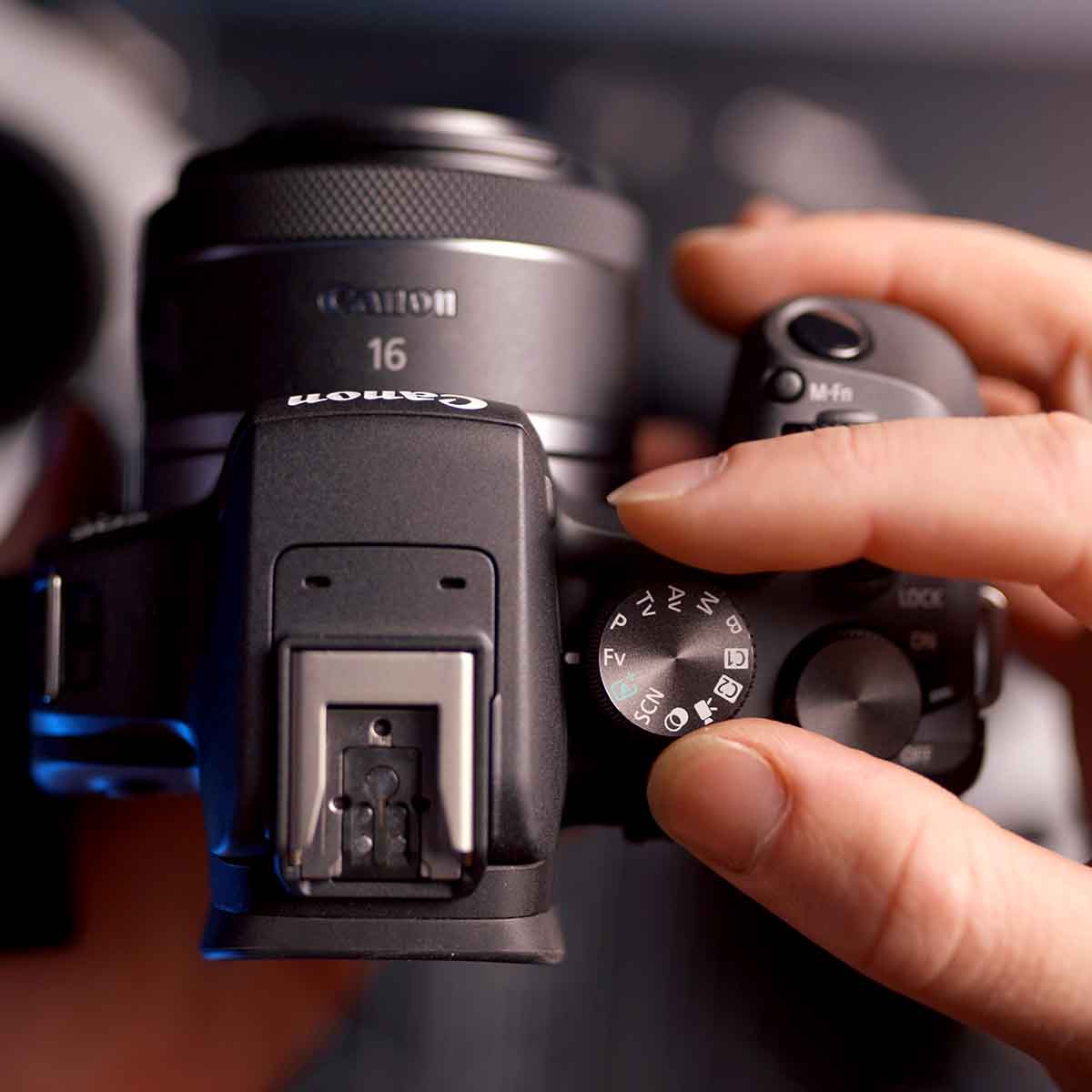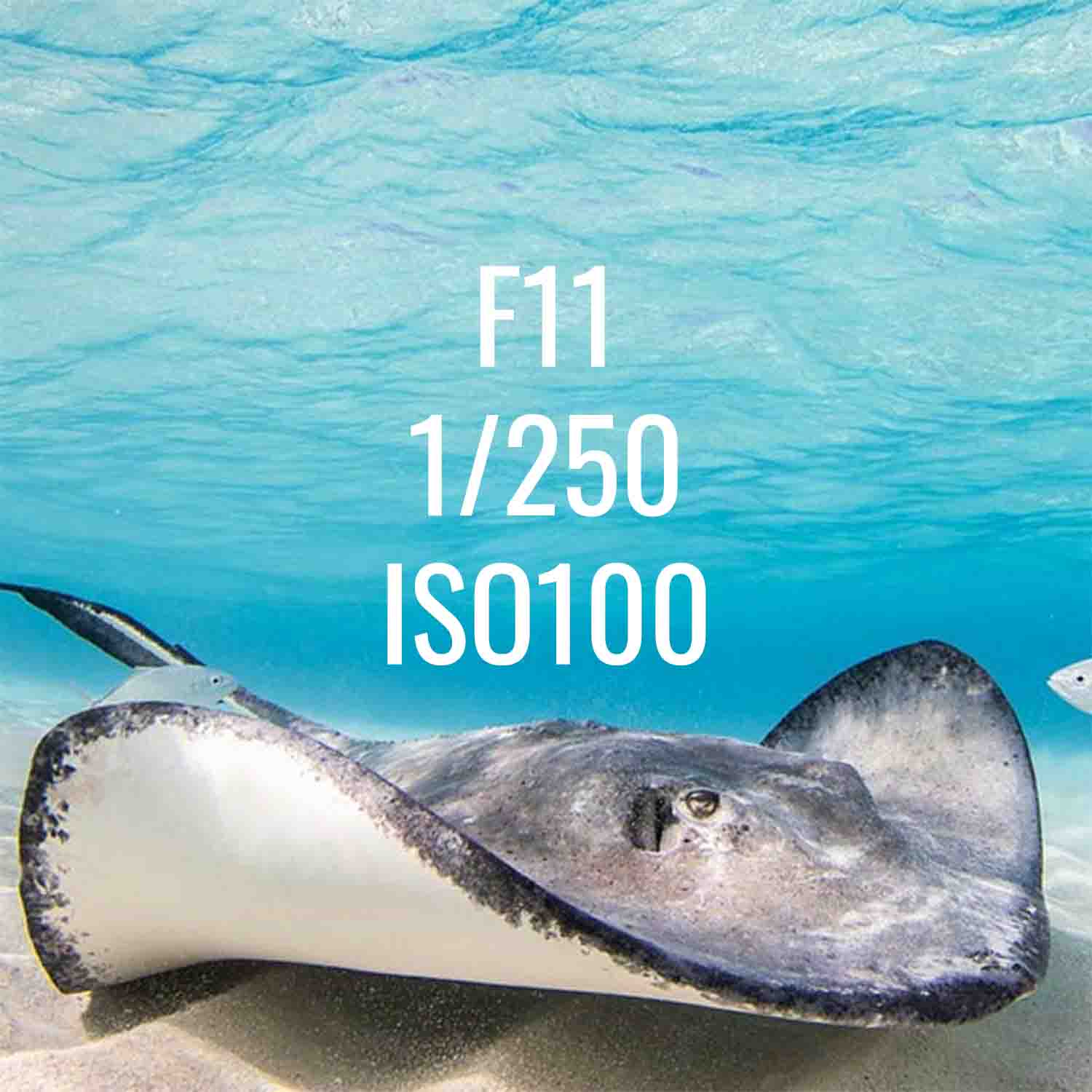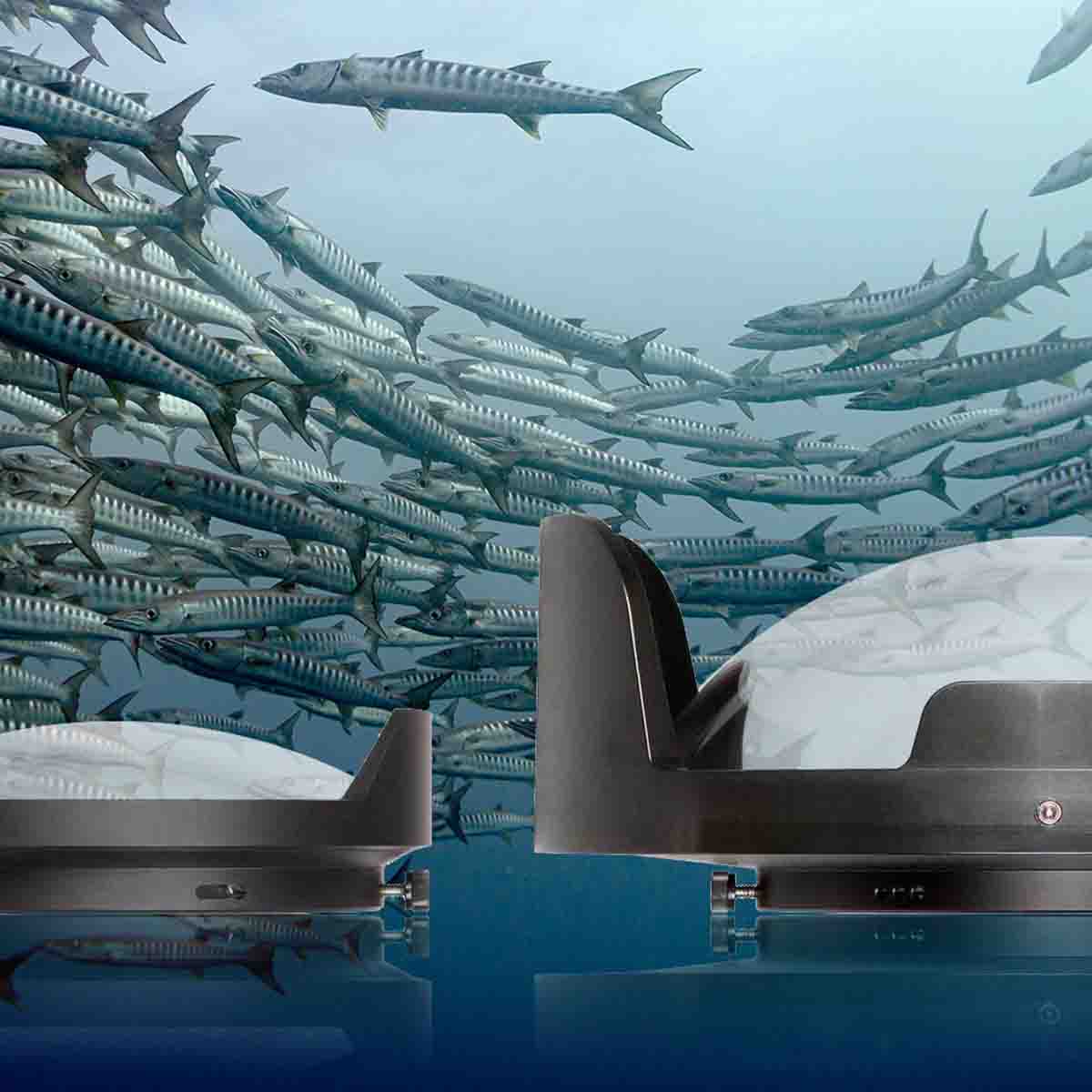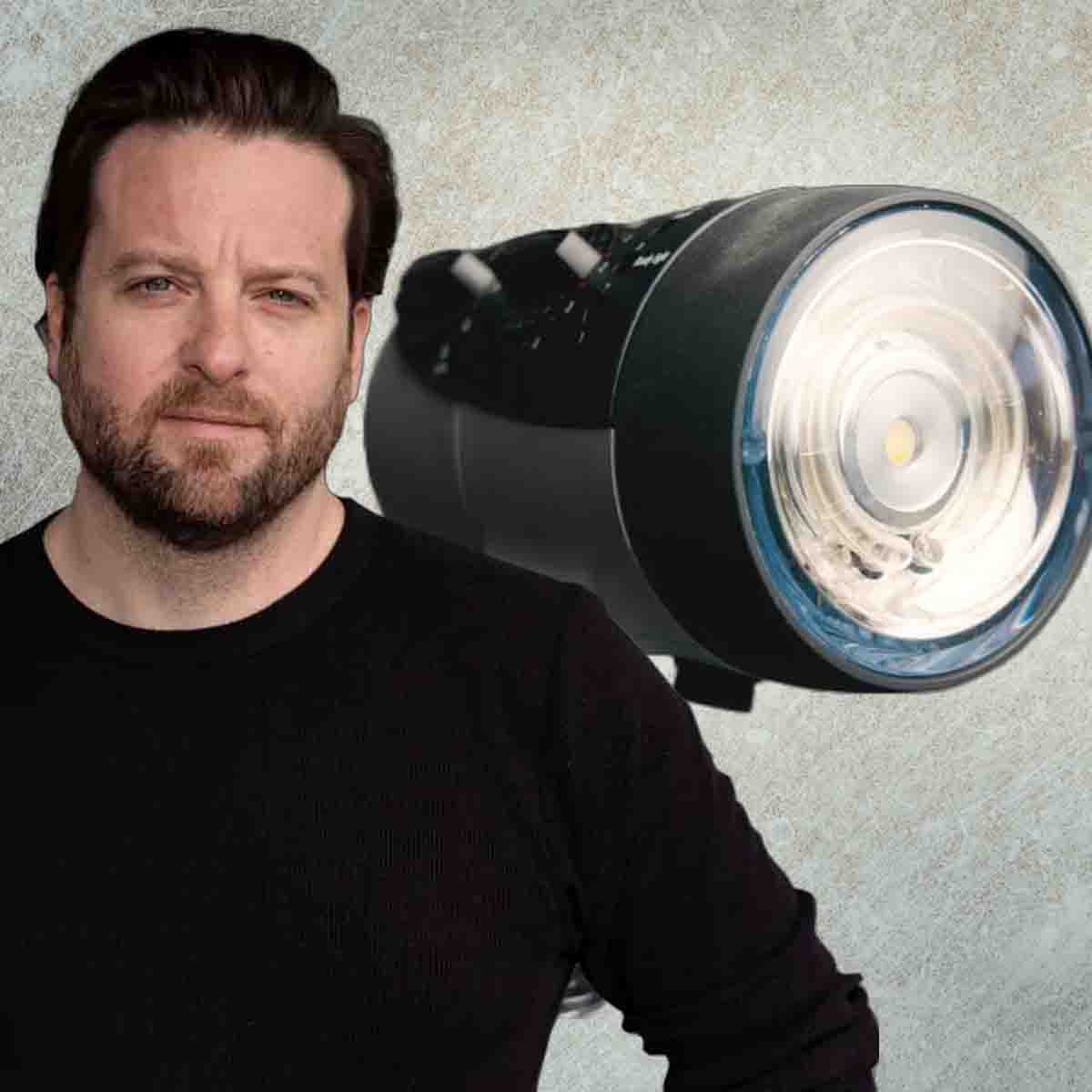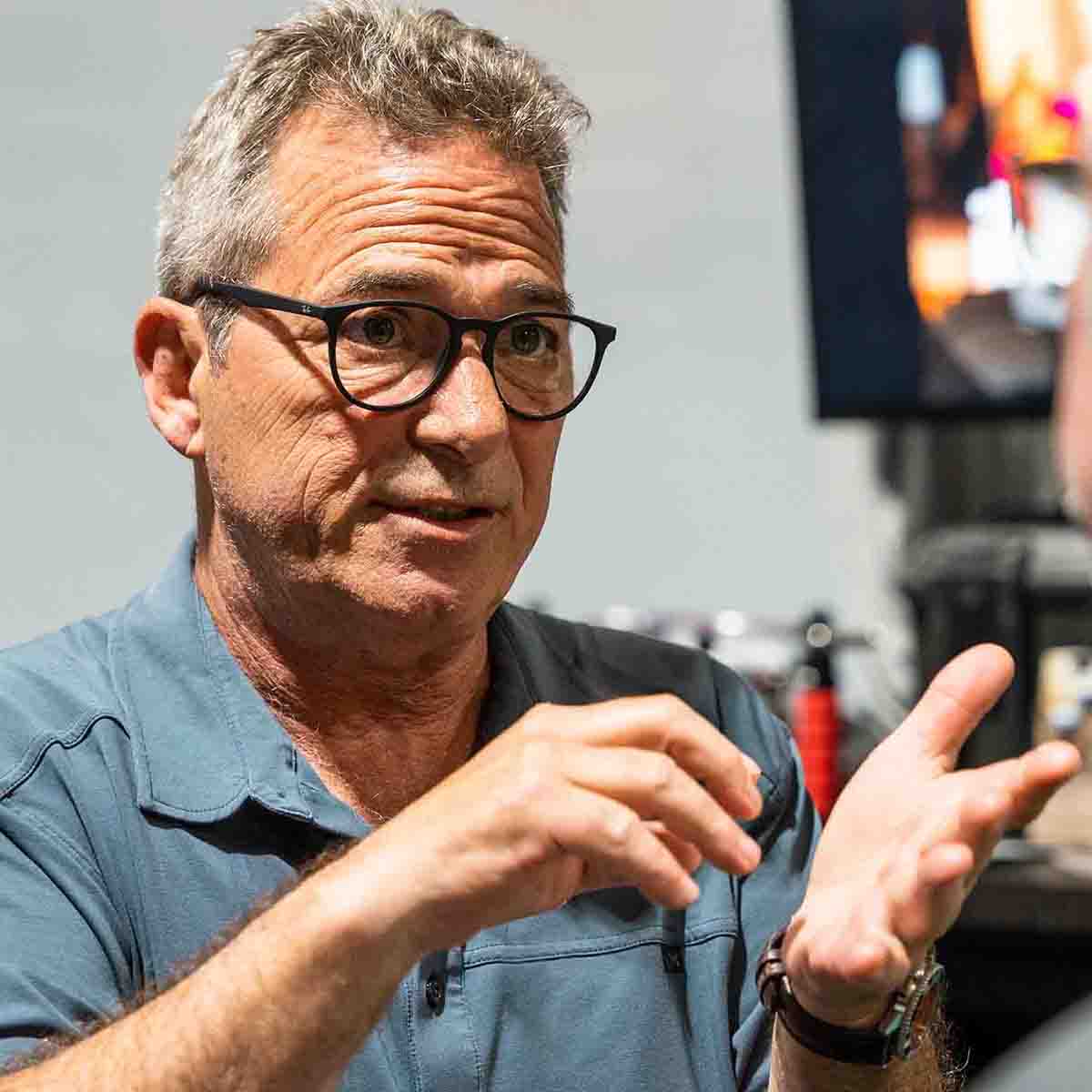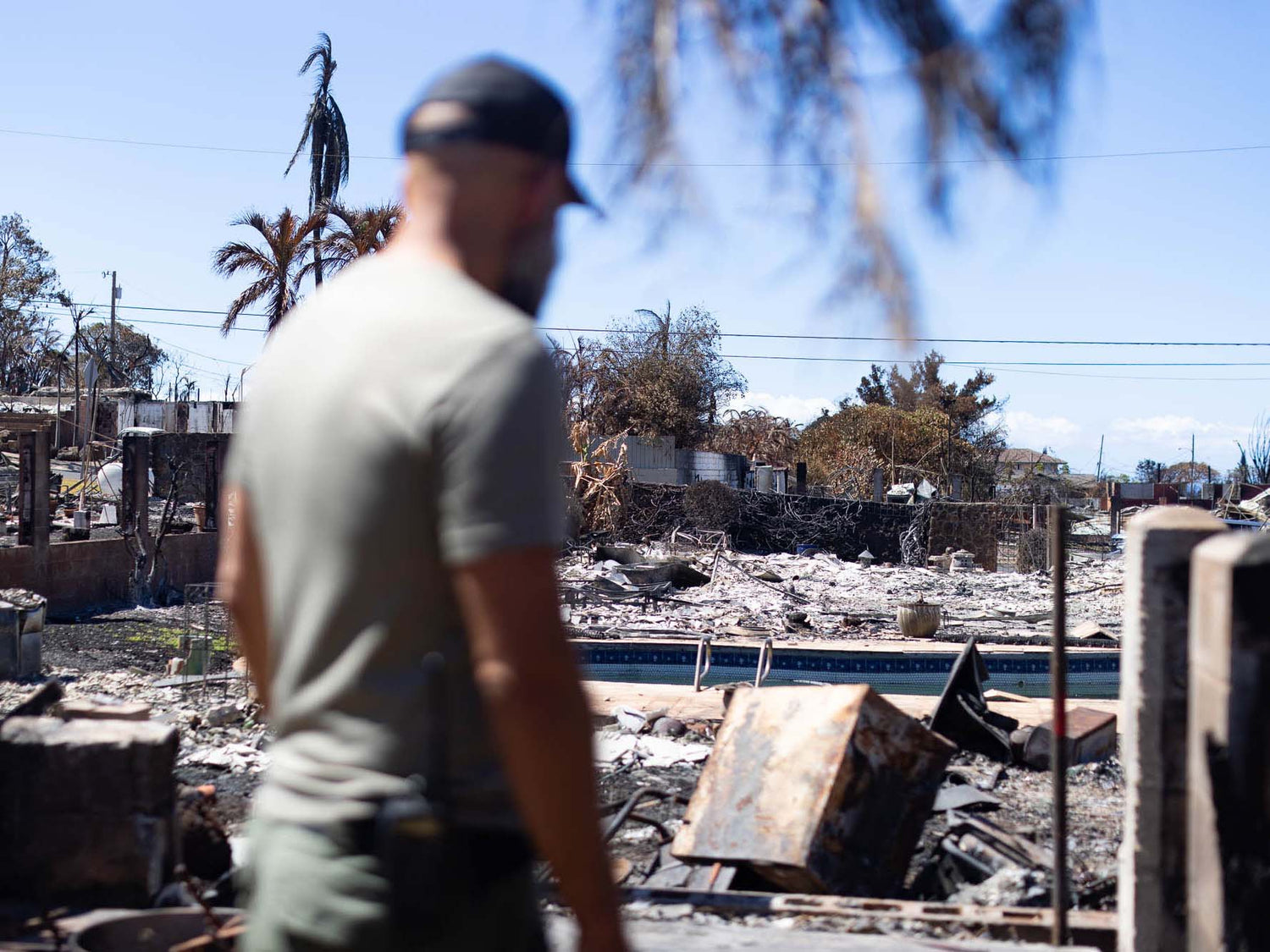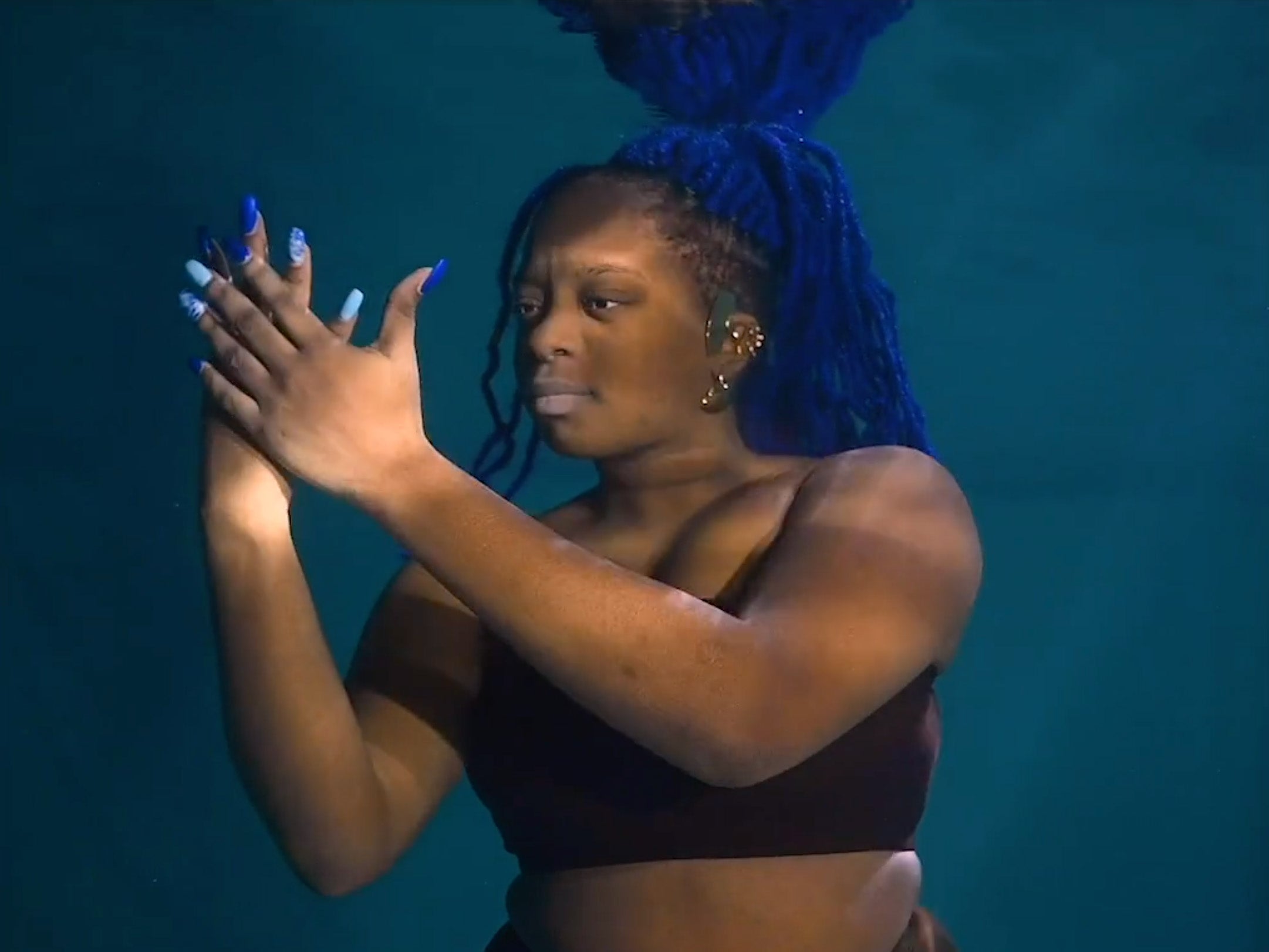By Andrew Raak
Images © Selket Kaufman
On August 8th, 2023, the island of Maui experienced the most devastating fire in U.S. history, with nearly 100 people killed and an estimated 12,000 Lahaina residents displaced. Within a day, the historical town of Lahaina was leveled to ash. The immeasurable impact of this fire on the community extends far beyond the physical damage. The lasting emotional, economic, and cultural impact will be felt for generations to come. In the course of my own chaotic last minute evacuation, I left everything that I loved to the onslaught of an uncontrollable fire.
"This would be the last time I would see my favorite coffee shops, food trucks, stores, and vessels before the all consuming fire turned everything into a memory."
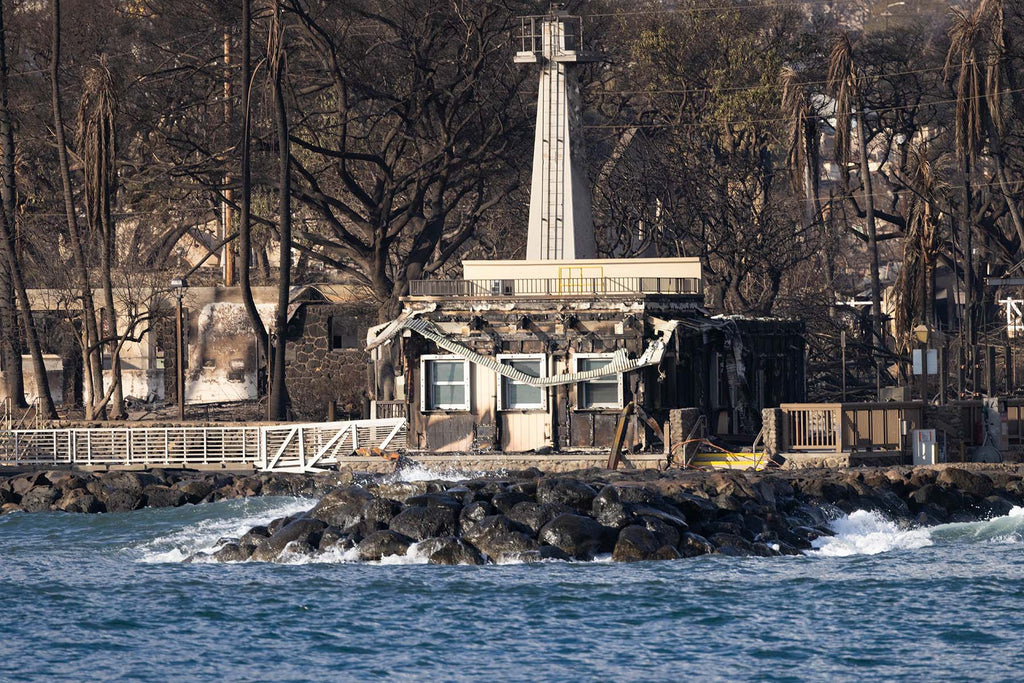
Burned coastal buildings pose potential threats to marine life from harmful runoff.
Image © Selket Kaufman // Maui Humane Society
The morning of the disaster, I planned to bunker down with friends to wait out the high wind advisory. We planned to play cards, share laughs, and cook together during the rainless tropical storm conditions. Nearby tree debris littered the ground. Occasional household items and tree branches would blow about the neighborhood.
At some point, we lost electricity, and cell service became intermittent at best. We continued our storm prep routine until my friend’s cat accidentally escaped their house and our group went searching outside for the missing animal. At this point we noticed the billowing smoke on the hill side was blowing toward downtown Lahaina.

Legacy buildings, like this 106 year old storefront, bare the brutal scars of the damaging fires.
Image © Selket Kaufman // Pacific Whale Foundation
As conditions worsened, I was driven to my small studio apartment downtown to retrieve some personal items, and my neighbor’s dog. I was only in the apartment a short time, but within minutes the smoke surrounding the town thickened from wisps of grey smoke to a midnight black smog. While exiting my second-floor apartment, I coughed through the darkness until I found some reprieve on Front Street by the ocean. I headed back to my group’s evacuation rendezvous point on foot, through the blistering 60 to 70 knot winds.
As I walked toward the harbor, taking the same route I took to work each day, I realized this would be the last time I would see my favorite coffee shops, food trucks, stores, and vessels before the fire turned everything into a memory. I piled into a car with my friends, and we drove through the heavy evacuation traffic. Behind us, a freight train of smoke pushed down the mountain side, burning everything in its path.
The Power of Grassroots Organizing
"Almost immediately, locals sprang into action; bringing supplies and support to the west side of Maui. With no cell phone service these brave responders establish the initial needs of the isolated areas."
The following week I was still very much in shock. I tried to connect with friends who were displaced by the disaster to make sure they made it out. Disaster doom scrolling on social media became an ongoing event throughout the following days. With little to no guidance from government entities, we turned to social media to obtain information, communicate needs, and coordinate support.
Almost immediately, locals sprang into action; bringing supplies and support to the west side of Maui. With no cell phone service these brave responders establish the initial needs of the isolated areas. People cleared out the shelves of Costco, Walmart, and Target. They packed their vehicles to the brim with essential supplies and delivered goods to the affected areas. Mariners loaded their boats with weary, grief stricken crew and brought supplies to the beaches of the west side just a few days after the fire.

Grassroots teams continue to lead the charge in relief efforts for those most impacted by the devastating fires.
Image © Selket Kaufman // Pacific Whale Foundation
The local response was intermittently disrupted as more governing agencies slowly interjected themselves into the efforts. Government agencies must have been surprised that the grassroots relief effort had established hotspots along the west side for delivered supplies. Donated radio communications, starlink transponders, gas, propanes, food, and drinkable water all came from private donations. Even to this day locals are leading relief efforts and providing ongoing support.
Temporary resource centers stabilized their supply chains within the first two weeks. In the weeks to follow, large organizations such as the American Red Cross, Federal Emergency Management Agency (FEMA), and even Airbnb helped displaced people find hotels and short-term rentals.
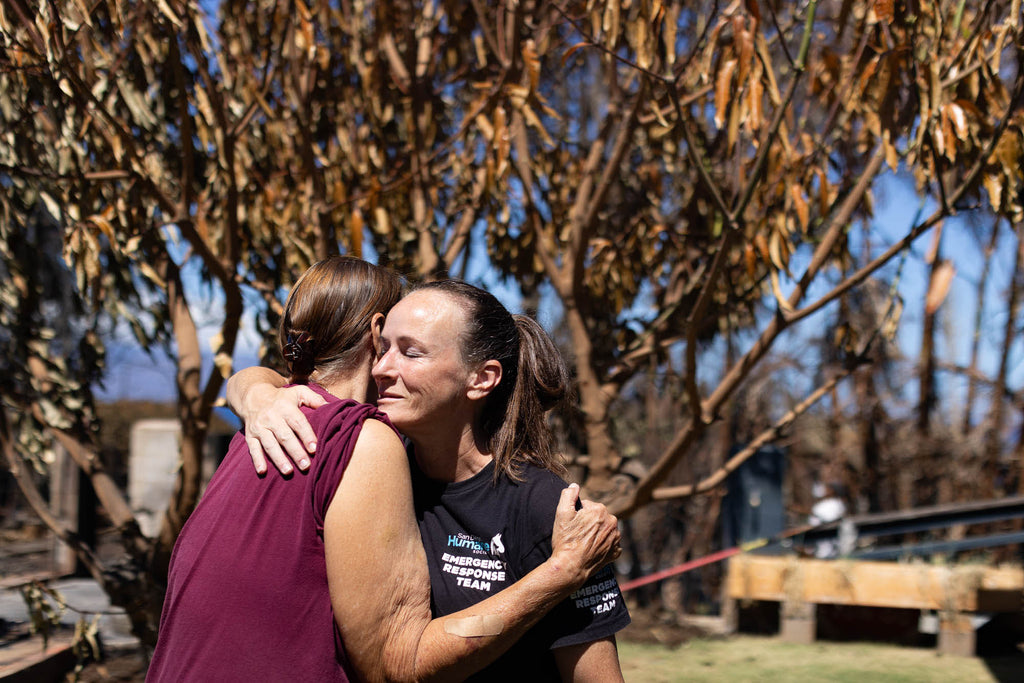
The emergency response team with the Maui Humane Society embrace after long days of searching for and rescuing surviving animals in Lahaina.
Image © Selket Kaufman // Maui Humane Society
An Uncertain Future
Ten weeks have passed, and the future is still uncertain for many of us on the island. Thousands of people lost their homes and remain displaced. Temporary hotel housing shifting for many. On October 8th, Governor Green proclaimed to open West Maui. The proclamation is a contentious topic for locals who are still reeling from trauma with no where else to go. As the Governor tries to restart the economy in West Maui, locals will need to put on a smile and return to servicing visitors.
The current housing crisis on the island leaves most of us without a clear secure future or for a roof over our heads. Hawaiians are once again being pushed out of their land due to decades long inequalities. Discussions about rebuilding Lahaina are bringing up historical conversations around land rights and water usage. Many locals feel unheard. Many have not even visited the remains of their homes or sifted through the ashes to recover memories of their old lives.

What's left of devastated buildings and homes in Maui. Many residents face a housing crisis with no clear end in sight.
Image © Selket Kaufman // Maui Humane Society
What now?
So what can you do to support Maui right now? Keep informed about ongoing needs by following local leaders These needs will change week by week. If you are inclined to donate money, donate directly to someone on the island. Many established relief funds have great intentions but operational costs erode funds before they reach those in need.
Visit Maui respectfully by staying away from Lahaina. The rest of the island has plenty to offer, so spend your time in those places. Showing respect while traveling is something we should always practice, regardless of the destination.
I recommend incorporating a day of volunteering to integrate yourself within the local community and gain cultural appreciation outside of curated resorts. Read up on the historical dynamics on the island during your 6-hour flight to Hawaii.
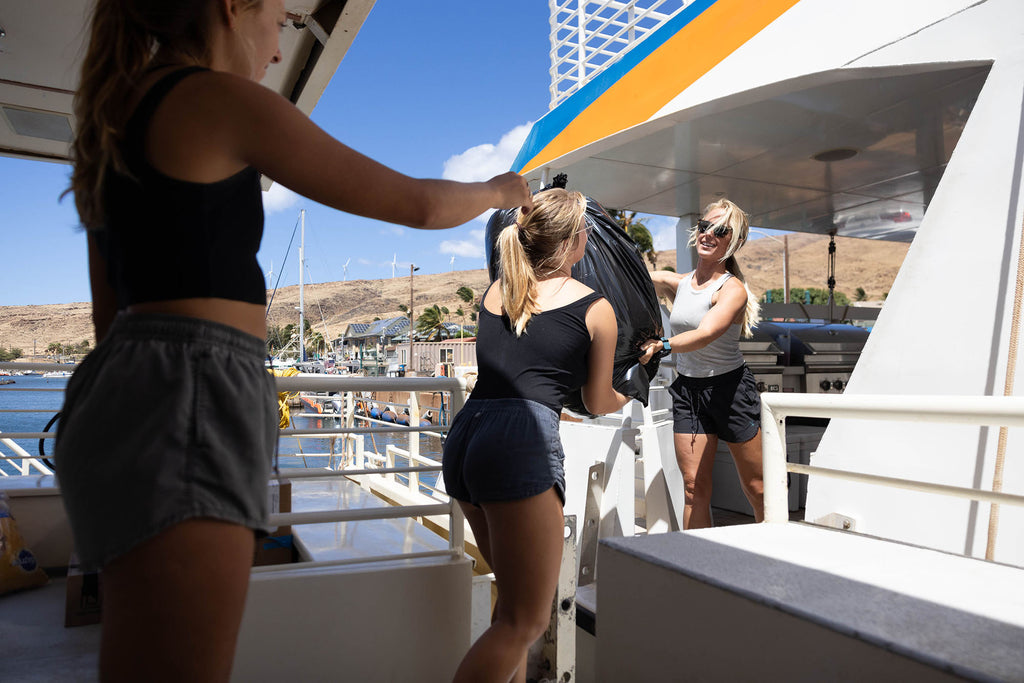
Grassroots volunteers at the marina help shuttle important relief needs to survivors.
Image © Selket Kaufman // Pacific Whale Foundation
Finally, do what you know. Whatever skill set you have, utilize that to help others. If you cut hair for a living, volunteer to give some hair cuts. If you’re an attorney, perhaps volunteer with those navigating legal difficulties that will arise. We serve others best by giving what we have, whether it be financially or through knowledge.
Connect with these social media accounts to find out daily updates and what the needs are on West Maui:
• @bkrvlogs
• @brown_kross_hui
• @mauinownews
Thank you to Selket Kaufman, photographer, visual journalist, and Maui resident documenting the many stories of survival in the wake of the Maui fires. Learn more about Selket on her website or Instagram @selket_kaufman.
 Ambassador Andrew Raak always dreamed about making a life on the water, and he has made it a reality. Andrew has a degree in Marine Science, a Captain's license, and is a certified dive instructor. At the moment he spends his days on the boat in Hawaii, when he's not traveling the world and teaching underwater photography. Read more...
Ambassador Andrew Raak always dreamed about making a life on the water, and he has made it a reality. Andrew has a degree in Marine Science, a Captain's license, and is a certified dive instructor. At the moment he spends his days on the boat in Hawaii, when he's not traveling the world and teaching underwater photography. Read more...
Additional Reading
Customer Photos | Elliot Omiya Since I was a Keiki
Gigantic Manta Rays Spotted in South Carolina [VIDEO]
The Power of Underwater Photography for Ocean Conservation

